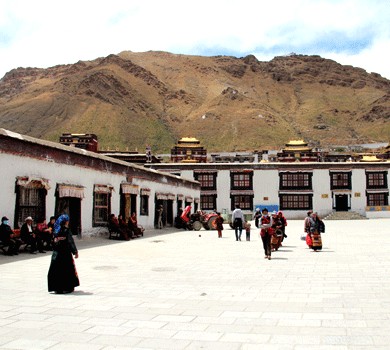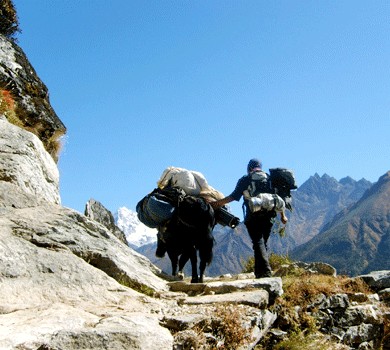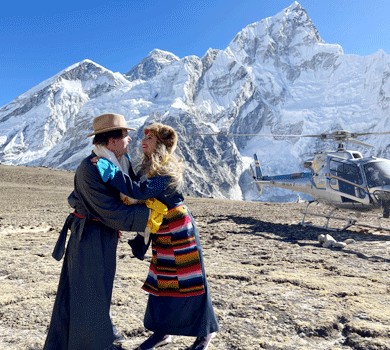Trekking Information
Hiking or Trekking is known as walking, which takes you along trails winding up and down, around himalayas or in hillside.Trekking is not mountaineering although some of the popular trails are used by mountaineering expeditions to get to their base camps. Most of the trails you walk on are still used predominantly by Nepali people for everyday travel and trade. It is not uncommon to be passed along the way by a Nepali porter carrying lengths of corrugated roofing iron slung.
When we trek, we will see a close view of mountains, History, People wildlife and nature. You will walk through the streets of cities and villages and past the open front doors of housesand their lifestyles and the magnificent mountains towering over you. By trekking you will be involved in a way you could never be in a car, bus, train or airplane; you can enjoy the friendliness of the people, feel the magnetism of the mountains, be at one with the country and at peace with yourself. Could you ask or want for anything more?
A trekking trip can be any length you choose. There are a number of short treks around the Kathmandu and Pokhara valleys which only take a day to complete. There are two or three day treks or treks from a week to a month. For those with the time you can combine a number of treks and spend months just walking around. Trekking plus can help you to put together a trek to suit your needs at an affordable price leaving you free of any kind of assistance for any kind of tour / trek in Nepa .
Why to Trek ?
The chain of the highest mountains on earth and it encompasses a region of deep religious and cultural traditions and an amazing diversity of people. If you have the time and energy to trek, dont miss the opportunity to see the spectacular beauty and the unique culture of Nepal. Fortunately for the visitor, there are still only a few roads extending deeply into the hills, so the only way to truly visit the remote regions of the kingdom is in the slowest and most intimate manner - walking. It requires more time and effort, but the rewards are also greater. If you have neither the patience nor the physical stamina to visit the hills of Nepal on foot, a helicopter flight provides an expensive and unsatisfactory substitute.
Trekking in Nepal will take you through a country that has captured the imagination of mountaineers and explorers for more than 100 years. You will meet people in remote mountain villages whose lifestyle has not changed in generations. Most people trust foreigners. Nepal is one of only a handful of countries that has never been ruled by a foreign power.
Many of the values associated with a hiking trip at home do not have the same importance during a trek in Nepal. Isolation is traditionally a crucial element of any wilderness experience but in Nepal it is impossible to get completely away from people, except for short times or at extremely high elevations. Environmental concerns must include the effects of conservation measures on rural people and the economic effects of tourism on indigenous populations. Even traditional national park management must be adapted because there are significant population centres within Sagarmatha (Mt Everest) and Langtang national parks.
When to Trek ?
There are two major factors to weigh as you decide when to go to Nepal: crowds and weather. Generally, the better the weather, the more people come to Nepal to go trekking. During the high tourist season in October and November, flights and hotels are fully booked and hotels and trails in the hills can be horrendously busy.
During autumn the nights are cold in the mountains, but the bright sun makes for pleasant day temperatures - in the high 20s? C, falling to 5? C at night, between 1000 metres and 3500 metres. At higher altitudes temperatures range from about 20? C down to - 10? C. Mornings are usually clear with clouds building up during the afternoon, disappearing at night to reveal spectacular starry skies. During winter, it is about 10 degrees colder.
The monsoon is a good time to visit Kathmandu, but there are few trekkers among those who come. A monsoon trek is possible if you are willing to put up with the rain, leeches, slippery trails and lousy mountain views. Flights operate throughout the monsoon to Lukla, Jumla and Jomsom, so it is possible to fly in and trek above the leech line.
Many of the new treks to recently opened restricted areas are good summer treks. Mustang and Simikot are partially in the Himalayan rain shadow, so trekking conditions are good throughout the monsoon season. Most of the restricted area treks are impossible during the winter season.
Climate
Nepal has four distinct seasons. Spring (March - May) is warm and dusty with rain showers. Summer (June - August) is the monsoon season when the hills turn lush and green. Autumn (September November) is cool with clear skies, and is the most popular trekking season. In winter (December February) is cold at night and can be foggy in the early morning, but afternoons are usually clear and pleasant, though there is occasional snow in the mountains. Because Nepal is quite far south, (at the same latitude as Miami and Cairo) the weather is warmer and winter is much milder at lower elevations, including Kathmandu at 1360 meters. It rarely snows below 2000 meters.
The monsoon in the Bay of Bengal governs the weather pattern. The monsoon creates a rainy season from the middle of June to the middle of September. It is hot during the monsoon and it rains almost every day, but it is a considerate rain, limiting itself mostly to the night. During this season, trekking in most of Nepal is difficult and uncomfortable. Clouds usually hide the mountains and the trails are muddy and infested with leeches.
It usually does not rain for more than one or two days during the entire autumn season from mid-October to mid-December. During winter and spring there may be a week or so of rainy evenings and occasional thunderstorms blanket the hills with snow. The Himalaya makes its own localized weather, which varies significantly over a distance of a few km. Despite the sanguine assurances of Radios that the weather will be "mainly fair throughout the kingdom", always expect clouds in the afternoon and be prepared for occasional rain.
Most of the precipitation in the Himalaya occurs during the summer monsoon. There is less snow on the mountains and on many of the high trails during winter. Everest itself is black rock during the trekking season, becoming snow-covered only during summer. There are always exceptions to this weather pattern, so be prepared for extremes. Winter snowstorms in December and January may make an early spring pass crossing difficult and can present an avalanche danger, especially on the approach to the High Mountains. Please feel free to inquiry us regarding to Nepal trekking information, we are ready to write you back any time.


